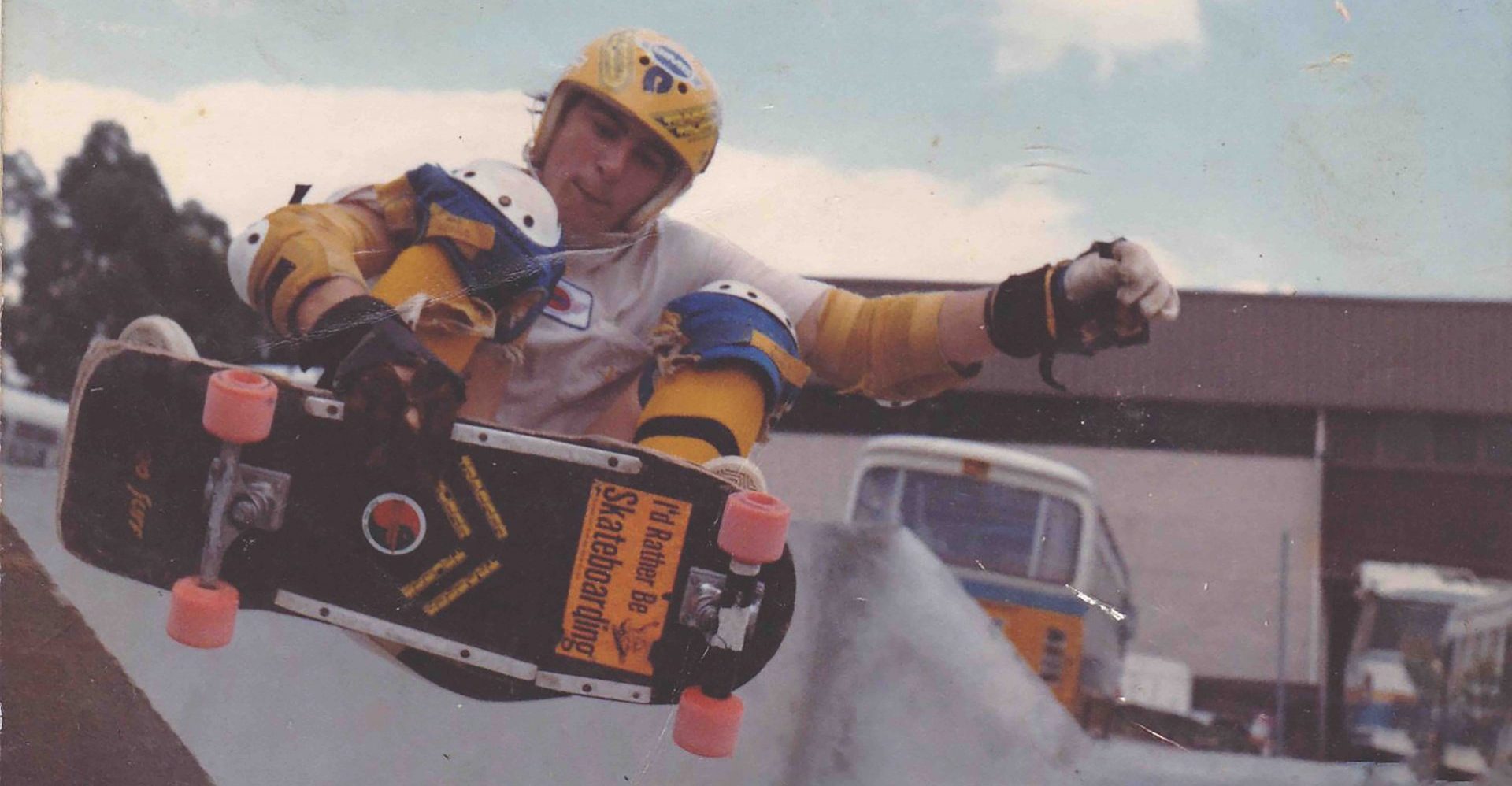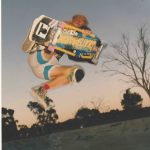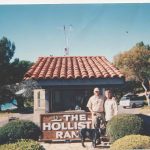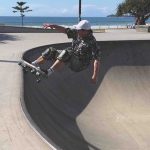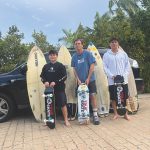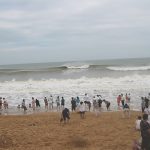Words: Dave Swan
As a former Australian Skate Out champion, past president of the National Skateboard Association of Australia, international skatepark designer and licensee of merchandise for mobile phone game sensation, True Skate, it’s fair to say Brad Shaw has accomplished a bit in his lifetime.
With that said, he’s pretty unassuming, I simply knew him as the dad of one of my son’s mates. Funny how you can meet and greet someone on so many occasions without knowing the weird and wonderful journeys of their past.
Brad and I were watching our sons play footy a few months back and chatting away when our conversation turned to surfing and skating. I was curious as to why he was so knowledgeable about both, and that lead me to enquire as to what it is exactly he does for work. His answer prompted me to invite him for a coffee the following week and get the full rundown. Little did I know he was what I would refer to as a ‘living legend’ of the Australian skateboard scene.
- Brad Keirle Park, Manly. 2003
- One of Brad’s latest creations, a new skatepark in Singapore
Brad was involved in the early days of skateboarding in Australia, back when Bahne Super Flex Skateboards were the craze circa ’74. He picks up the story.
“I got into skateboarding basically around the same time as everyone else. I was around ten living in Sydney. The skateboard craze that hit Australia was massive after fibreglass skateboards with urethane wheels and some skating movies came out. It was a crazy time. Every kid in the street was riding skateboards.
“I was into it for a couple of years, and then I stopped for a bit until about ’78. It was around this time that I went to this skate shop, Skateboard World, and was just blown away by how much skateboards had evolved. They were all so modernised and so much better to ride with red translucent wheels and wider trucks.
“I pretty soon got back into riding with my neighbour. We used to skate these little banks around Sydney that were obfuscated drains and definitely not for skateboarding – places like The Boat Ramp and Harris Park Bowl were fun, but challenging. This is when I built my first skate ramp in my backyard.”
By ’78, the pool skating craze had made its way from Venice Beach California to Australia, and introduced Brad to a whole new dimension of skateboarding. His go-to place, along with a bunch of his mates, was Pymble Pool, a huge eight-foot-six-high empty pool.
“There were like 30 other local guys that went there. Everyone knew everyone because it was the only spot in Sydney. It was like the one surf break in town. It was a lot of fun but had four feet of vert and was scary.
“When that closed, Manly Skate City opened up and it had all of these fibreglass ramps. This was a big step up because it was a smooth and a proper skatepark. The same 30 guys would skate there for the next couple of years before another one opened up in 1980 where I lived in North Ryde, Sydney. It was a crazy, massive, concrete thing with bowls, halfpipes and banks. I was fairly kinked, but it was my local.”
Brad left school at 16 and started working at Skateboard world in Burwood, where he also got sponsored as a team rider. When Brad was 17 he moved to Cronulla and soon discovered a love for surfing. During that period skating took a bit of a back seat as he didn’t have a car and there were no skateparks nearby. In ’83 he headed over to California.
“I went to California for a month with Dave Mock and stayed down in Solana Beach with Chip Morton. He was the manager of the Del Mar Skate Ranch – the main skatepark
- Brad at Ryde Skatepark 1985
- Building ramps in Mumbai, India 2002
where the likes of Tony Hawk and all of these top pro skaters went. Back then, Tony was just 14 years old and a little skinny thing, but you could already see that he had something special.”
Now, even if you don’t know much about skateboarding, it is likely you recognise this name. Tony Hawk is to skateboarding as what Kelly Slater is to surfing. Both are renowned all over the world as some of the all-time greats in their chosen sports.
“I lived in California for basically seven years. I was mostly surfing in that time. The Del Mar Skate Ranch closed around ’88, so there was nowhere to skate anyway except some backyard ramps.
“One of the guys I surfed with there, Rick, owned a restaurant up the road which I worked in for a few years . He grew up surfing Rincon, which is an amazing right point break, but he also used to surf a place called The Ranch which is a private 10-kilometre coastline with premium surf breaks. It’s extremely hard to get to and surf though.”
For any of our readers who are unaware, The Ranch is, from a surfer’s perspective, one of the most coveted stretches of California coast just north of Santa Barbara. As it is private property, the only way to access it is by boat, or by way of invitation by someone who owns a parcel of land in the area.
Envisage undeveloped hills overlooking a near perfect, consistent surf break with an empty lineup. Whether it be myth or legend, The Ranch is considered to be Valhalla to many surfers. Back in the 80s, it would have been even more so. That said, I have never been, so I can’t speak with firsthand knowledge. Needless to say, I was pretty envious of Brad’s experience. That is until he mentioned my nemesis, the one thing that brings out the Chicken Little in me.
“My friend Rick was also friends with a surf legend named Ray Kunz. He worked on the gate at The Ranch, so we got free entry whenever we wanted. There was hardly anyone else there most of the time, which was great, although it was always a bit eerie because the water was cold and there was all this kelp. We were always there quite late too and I was very paranoid about sharks.”
- Ray and Ric – My Ranch access buddies
- Brad surfing Drakes at the Ranch, California – Pic by Rick Doyle
There, he said it, sharks, and not any old sharks, this is where the mighty great white shark is seemingly in abundance. The Ranch is close to the area colloquially known as The Red Triangle, a roughly triangular-shaped region off the coast of northern California where around thirty-eight percent of recorded great white shark attacks on humans in the United States have taken place — about eleven percent of the worldwide total. Anyhow I digress, apologies for my paranoia, back to Brad’s story.
“We would surf at The Ranch and at Rincon a lot. Rincon, you know, is amazing. It is pretty rare to find it uncrowded, but it just has these perfectly shaped waves – probably the best I’ve ever surfed. We would see Tom Curren out at these spots sometimes. Surfing there was a real highlight of my time in California.”
Towards the end of ’86 Brad moved back to Australia, albeit for only a couple of months. He had well and truly caught the travel bug and yearned to return to the United States for more adventures.
During his time back home, there was a Coca-Cola skate-out event in Manly. Specifically, it was the Coca-Cola Pro-Am skateboarding competition series held at skateparks around Sydney for the first time in Australia. Long story short, even though Brad regarded himself as more of a ramp skater (and this being a street competition), Brad won the Manly regional comp.
“Street skating is when you hit little jumps and boxes. Back then, it wasn’t like today where it’s so technical. It was basically just a small bunch of little portable ramps – no big bowls or half pipes. Anyhow, they had all these regional events, including one where you could qualify for a grand final of the Australian Coke Skate Out championships in Australia’s Wonderland. Even though I was a ramp skater, I ended up winning the whole thing.”
I must at this point of the story inform our readers Brad wasn’t all too forthcoming with these details. I had to pry it out of him, such is his humility.
Brad headed back to the US again for a couple of years before returning home to Australia around ’87 where he encountered a bit of a snag in his back-and-forth jaunts to America.
“I was coming back to California via Hawaii when immigration went through my stuff and found that I had a diary note saying I had worked in the US the year previously. Basically, I got busted by immigration. I could have gone against a judge and pled my case, but I wasn’t going to risk it, so 12 hours later I was on a plane back to Sydney.
“My visa was cancelled for five years. I couldn’t get into the US. I wanted to go back there though, it was great – I had friends, a job and a life there. So about three months later I figured out I could get in via Mexico. I’d been there before, I knew you could just walk over the boarder without ID, so that’s what I did.
“I flew into Cabo San Lucas (in the Baja California peninsula in northwestern Mexico) and then got a flight back up to Tijuana (near the US border). It was like a 45-hour trip, which was crazy. I had some friends meet me at the border and I just walked right over it and got picked up on the other side. I was there for over a year illegally, went back home to Australia to see my family for Christmas, and did the same thing all over again for another year.”
- Brad surfing Drakes at the Ranch, California – Pic by Rick Doyle
- The Airwalk shoe Brad named the Vic
Ahh yes, my son’s friend’s dad is a criminal. Jokes aside, I think almost everyone around our vintage has possibly worked illegally while abroad in their younger years. ‘Things were different back then,’ we tell our kids, justifying why we broke the law. We certainly wouldn’t do it nowadays and advise our children not to do the same – responsible parenting 101.
In between his California visits, Brad started being involved with a shoe company called Airwalk. This Southern Californian sport-lifestyle brand was intrinsically tied to action sports and music, and in those days was markedly bigger than the likes of both Vans and Skechers. It was through working for Airwalk, Brad got to meet Tony Hawk and a bunch of the pro skaters that were then on the Airwalk team.
“In ’92 my father died, so I came back to Australia to help my mum out. I started working for Airwalk here for a while as a national team manager for their skate, snowboard surf and BMX divisions. Airwalk had the biggest action sports team in Australia, so we toured with Tony Hawk around Australia doing the Big Day Out Tour.
“My good friend named Sin was head designer at Airwalk, which was how I came up with one of the iconic Airwalks shoes called the Vic.
I stopped working for them in 1997 when I broke my leg snowboarding.
“Then, around ’98, me and a couple of other guys I knew created the National Skateboard Association of Australia, which I became president of for over ten years. We did a lot of skateboard events – everything from national titles and street events to all sorts of competitions, judging and coaching.”
- Brad carving it up today at the Alex Headland Skatepark
- SMP Skatepark in Shanghai, China
- Brad during construction of the Rizhao Skatepark, Shandong, China
- Brad with his sons Noah and Mark and their True Skate boards
- Beach break in Rizhao, China
Brad went to India to design and build skate ramps. He would spend the next five years in China, namely living in Shanghai and Nanjing, travelling with his wife and another business associate and endeavouring to spread his love of skateboarding and building parks.
However, this was well before skateboarding was introduced into Olympics, so its popularity was nowhere near what it is today. Very few in China skateboarded back then, but nowadays there are some 300 skateparks. Indeed, it was around 2005 when Brad managed the SMP skatepark in Shanghai – the biggest skate park, not just in China, but in the world at the time.
While he was in China in 2006, Brad also surfed with his buddy Graham McKnight at Hainan Island in the south and Rizhao in the north.
“They had perfect, peaky point breaks and clear, warm water. When I surfed Rizhao, I was the only westerner around.
“I think I was the first person to surf this beach break. People were in awe. I think they were just wondering what this foreign guy was doing.”
In 2007, it was back to Australia, this time living, skating and surfing on New South Wales’ far south coast in Ulladulla. However, when Brad’s mum got sick he moved back to Sydney with his wife and son.
“Around 2008 I was also a private investigator for a while, mostly doing surveillance work. I remember I was watching a very important person’s house once who had death threats against him. The neighbours had lit fire bombs in the house next to his accidently. Woops.
“In 2009, Cary Pogson and I started my skatepark business, Sk8Scapes, which I still have today. We started building skateparks around Australia. I was actually still doing a lot of stuff in China back and forth. That’s when, in 2013, we got the contract to build one in Guangzhou, which ended up being the biggest skatepark in the world. It’s about 15,000 square metres, over three football fields, and it’s in the middle of ten universities and 160,000 students.
“I’ve built and designed a lot of parks in China over the years, and indeed all over the place. Around this time I was involved with the Chinese Extreme Sports Association judging comps and running events.
“All last year I was busy building a big skate park in Singapore. I am also setting up a skatepark company in India with a few guys. My wife is Japanese, so we will launch my business in Japan very soon as well.
Brad has not only been busy with skating in the real world, he has also taken a keen interest in the virtual world being the international licensee for merchandising for a digital skateboard game.
“The game is called True Skate. It’s become the number one skateboard game in the world with over two hundred thousand users a day, so it’s just massive. The parent company from Melbourne, True Axis, also does True Surf, which is a huge game as well that sponsors the World Surf League.
“There is also going to be a snowboarding and BMX game down the track, as we are planning to have a complete action sports portfolio. True Skate is probably the most serious thing I am working on at the moment because it’s such a big, global opportunity.
“We are currently in talks with the International Olympic Committee about our game’s e-sport platform, because the Olympics is reportedly going to undertake e-sports very soon.”
It is clear Brad has quite a few things on the go. Almost as many things as boards in his impressive skateboard collection which dates back to the sixties, but that’s a topic for another story down the track.
Like I said earlier on in this story, it’s funny what you find out about someone who you feel you’ve known for years when you have a chat watching your kids run around a footy field. Brad Shaw, it is both a privilege to know you and share your story.
